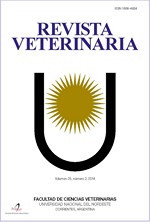Dermatosis autoinmunes en caninos. Estudio retrospectivo
DOI:
https://doi.org/10.30972/vet.3013916Palabras clave:
Canino, dermatosis autoinmunes, histopatología, estudio retrospectivoResumen
Se investigaron muestras de piel de caninos con diagnóstico de enfermedad autoinmune ingresadas entre los años 2004 y 2016 al Laboratorio de Patología Especial Veterinaria (FCV, La Plata, Argentina). Los objetivos fueron identificar casos de caninos con lesiones cutáneas y seleccionar aquéllos con diagnóstico de enfermedad autoinmune. También se propuso relacionar las dermatosis autoinmunes con la raza, edad, sexo, el tipo y la ubicación anatómica de las lesiones clínicas y, por ultimo, describir las diferentes lesiones histopatológicas que caracterizaron cada afección. Las enfermedades autoinmunes representaron el 2,07% del total de casos ingresados en el período de estudio, siendo las más frecuentes el pénfigo foliáceo y el lupus eritematoso discoide. Los caninos de raza pura fueron más afectados que los mestizos, siendo la región dorsal de la nariz la ubicación anatómica de mayor presentación (35,3%). Entre los hallazgos histopatológicos más reiterados se observaron pústulas (54,1%), áreas de separación dermoepidérmica (45,9%) y espongiosis (44,7%). Si bien el porcentaje de caninos con dermatosis autoinmunes es bajo, es importante incluirlas dentro de los diagnósticos diferenciales de las enfermedades que cursan con pústulas, pápulas, vesículas e infiltrado inflamatorio en la unión dermoepidérmica. La histopatología es una herramienta útil y relativamente accesible en nuestro medio, que permite arribar al diagnóstico de tales enfermedades.
Descargas
Descargas
Publicado
Cómo citar
Número
Sección
Licencia
Derechos de autor 2019 C Sieben, A R. Massone, M A. Machuca

Esta obra está bajo una licencia internacional Creative Commons Atribución-NoComercial 4.0.
Política de acceso abierto
Esta revista proporciona un acceso abierto inmediato a su contenido, basado en el principio de que ofrecer al público un acceso libre a las investigaciones ayuda a un mayor intercambio global de conocimiento. La publicación por parte de terceros será autorizada por Revista Veterinaria toda vez que se la reconozca debidamente y en forma explícita como lugar de publicación del original.
Esta obra está bajo una licencia de Creative Commons Reconocimiento-NoComercial 4.0 Internacional (CC BY-NC 4.0)










.jpg)
.jpg)



